B6.2 Animals: rats, mice, snakes and birds
Rats, mice and other vermin such as snakes and birds can spoil food, contaminate surfaces in the house, and pollute the water in the rainwater tank or main water supply. As discussed in A1.3 ‘Cabling and wiring’ mice and rats can also cause electrical faults by chewing the protection from cables, particularly in ceiling spaces above bayonet light fittings. Snakes can also lead to direct injuries.
Rats, mice and other vermin can gain access to houses through ventilation panels, cracks in walls, edges of roofs, wall, floor, door and window junctions, or the access points for electrical wiring and plumbing. They may also live and nest in framed walls, sub-floor spaces, ceiling spaces, under stoves, and around hot water systems.
Before commencing design, talk to the residents and housing manager about local vermin and identify appropriate design strategies.
Data from over 6,000 houses show that mice and rats are still a house design issue with 52% of houses reporting the presence of mice or rats during the year and 38% of houses with evidence being found of their presence at the time of survey. Many household residents (63% of houses) reported no ‘other pests’. ‘Other pests’ are defined as white tail spiders, redback spiders, any type of snake, wild camels, pigs, horses, crocodiles, rabbits, donkeys or ticks. These houses may have had dogs, cats, mice, rats, flies, mosquitoes, ants and cockroaches.
Data shows that most houses (70%) had some type of framed wall construction that without well designed, specified and constructed linings could provide habitat for rats, mice, snakes and other vermin. There was a significant decrease since 2013 in the number of houses with holes or cracks in inside walls, a 10% reduction, and outside walls, a 9% reduction. This reduces the risk of vermin entry, nesting and damage.
The efficient disposal of food scraps and rubbish from the house, particularly the kitchen, can reduce the presence of pests. Only 32% of houses surveyed had a working rubbish bin in or near the kitchen.
Real world examples of problems
-
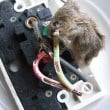 Rodent damage to light switch. The mouse was found electrocuted in the wall still attached to the switch.
Rodent damage to light switch. The mouse was found electrocuted in the wall still attached to the switch. -
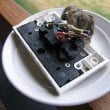 Rodent damage to light switch
Rodent damage to light switch -
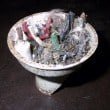 Rodent damage to light fitting. The warmth from the incandescent bulb encourages mice to nest above the fitting and chew on cables leading to short circuits and fires.
Rodent damage to light fitting. The warmth from the incandescent bulb encourages mice to nest above the fitting and chew on cables leading to short circuits and fires. -
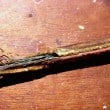 Rodent damage to electrical cabling
Rodent damage to electrical cabling -
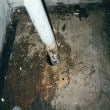 Rodent damage to waste water pipe
Rodent damage to waste water pipe -
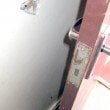 Lack of door stops and door handle damage to soft wall materials can combine to allow entry points for mice into wall cavities and cabling.
Lack of door stops and door handle damage to soft wall materials can combine to allow entry points for mice into wall cavities and cabling.
-
Design and Specification
Consider
- using conduits for electrical cables in ceiling spaces
- using strong internal wall materials up to at least 1800mm from the floor to prevent accidental damage, such as moving furniture or door handles damaging walls, that might enable access by rats, mice and other vermin
- designing vermin proof pantries or food storage cupboards
- selecting stoves with a vermin proof shell or vermin proofing kit
- avoiding the use of standard bayonet-type light fittings on the ceiling to prevent mice nesting in the ceiling space above the fitting
- specifying solid seals around plumbing, drains and electrical conduits
- fitting weather strips on all external doors
- avoiding insulated sandwich panel construction for walls, where bottom wall plates and panel joining strips are subject to water and physical damage, as the insulated core can then harbour rats, mice and other vermin.
- the use of insulated sandwich panel ceiling systems, with well sealed edges, to prevent mice breeding places in ceilings and provide a good clear working surface for maintenance contractors.
Quality control
- wall materials and floor to wall detailing inside and outside the house for gaps and voids that may allow rodent entry

- COMPLETED DESIGN & SPECIFICATION
AT HANDOVER
FINAL COMPLETION
- COMPLETED DESIGN & SPECIFICATION
- any roof vents, gable end vents, evaporative cooling system ducts, eaves linings and wall to ceiling junctions for rodent entry points

- COMPLETED DESIGN & SPECIFICATION
AT HANDOVER
FINAL COMPLETION
- COMPLETED DESIGN & SPECIFICATION
- door stops have been fitted to prevent wall damage from door handles

- COMPLETED DESIGN & SPECIFICATION
AT HANDOVER
FINAL COMPLETION
- COMPLETED DESIGN & SPECIFICATION
- weather strips are fitted on external doors, if specified

- COMPLETED DESIGN & SPECIFICATION
AT HANDOVER
FINAL COMPLETION
TRADE TEST
- COMPLETED DESIGN & SPECIFICATION
- metal flashings or cover strips are properly fixed on steel clad houses.

- COMPLETED DESIGN & SPECIFICATION
DURING CONSTRUCTION
AT HANDOVER
FINAL COMPLETION
- COMPLETED DESIGN & SPECIFICATION
- wall materials and floor to wall detailing inside and outside the house for gaps and voids that may allow rodent entry
Maintenance
As part of cyclical maintenance:
- if there is an observed pest problem, establish a pest reduction program carried out by a licensed contractor

- Pest Controller, Housing Management
- 6 Months
- repair holes, cracks or gaps that allow rodent entry

- Carpenter, Local Maintenance Team
- 6 Months
- cut back tree branches that are near to, or touching, the house that may provide vermin entry.

- Local Maintenance Team, Housing Management
- 12 Months
- if there is an observed pest problem, establish a pest reduction program carried out by a licensed contractor
